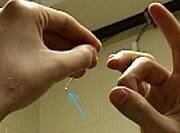 |
 Return to Methods List |
Methods in Neuroscience Whole Cell Patch Clamp Technique - FILLING PIPETTES |
| Below are photos of some key steps involved in filling the glass patch pipette and removing any air bubbles that may remain after the pipette is filled. Patch pipettes commonly have resistances of 1.0 -2.0 MOhm. |
|
Filling the Patch Pipette Click HERE for a short video (7.4 MB) about filling patch pipettes. |
||
To make an instrument for filling glass pipettes, a 1cc plastic syringe can be heated over a Bunsen burner and then stretched to form a long, thin tube. |
 Oftentimes after the glass pipettes are pulled they are placed in a covered dish to keep dust from settling on them. Dust can prevent the formation of a tight seal. |
 The syringe is filled with intracellular solution and inserted into the pipette. The solution level in the pipette is shown by the blue arrow. |
 The tip of the filled pipette is carefully flicked to force air bubbles that remain in the tip to rise. You will be able to see this happen. If air bubbles remain in the tip, the electrode resistance will be extraordinarily high. |
 The end of the glass pipette slides over the wire of the electrode holder. The wire must contact the solution inside the pipette. |
 The glass electrode is then firmly screwed into the holder. |
 The final view after the glass pipette is attached. Note the plastic tube coming out the side of the electrode holder. This tube is used to apply suction to the back of the glass pipette. Applying suction helps seal the tip of the pipette onto the cell. |
 A close up view of the patch clamp headstage. (No pipette is attached to the electrode wire.) The headstage sends the signal recorded by the electrode to the main patch clamp amplifier. |
 Here (colored in pink) you can see how the tube coming from the side of the pipette holder is attached to the syringe that applies suction. Suction can also be applied by mouth. |
| Overview | Web Lectures | Fellowships | Activities | Home | SFN | NAS | IBRO |